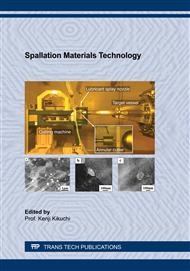p.87
p.95
p.103
p.111
p.121
p.127
p.135
p.145
p.151
Neutron Radiation Effects on Lubricants and O-Rings for Target and Accelerator Applications
Abstract:
Lubricants and O-rings are necessarily used for the construction of many accelerator-driven facilities as spallation sources or facilities for the production of radioactive isotopes. During operation, such component will absorb high doses of mixed neutron and gamma radiation, that can degrade their mechanical and structural properties. Experimental radiation damage tests of these components are mandatory for the construction of the facility. Methodologies for irradiation in nuclear reactor mixed fields and post-irradiation examination of lubricating oils, greases and O-rings were developed and are here presented. Samples were characterized with standard mechanical and physical-chemical tests. Parametric studies on the dose rate effects have been performed on O-rings. A case studies for a specific O-ring application in a gate valve has been developed. Some of the tested samples showed a dramatic change of their properties with dose, while others remain stable. Results were collected on nine commercial greases, on one oil and on four commercial elastomeric O-rings. The most radiation resistant among the selected products are now considered for application in facilities under construction. The main mechanisms of neutron and gamma radiation damage on these polymers were investigated at the mechanical and structural level.
Info:
Periodical:
Pages:
127-133
Citation:
Online since:
March 2021
Authors:
Keywords:
Price:
Сopyright:
© 2021 Trans Tech Publications Ltd. All Rights Reserved
Share:
Citation:


